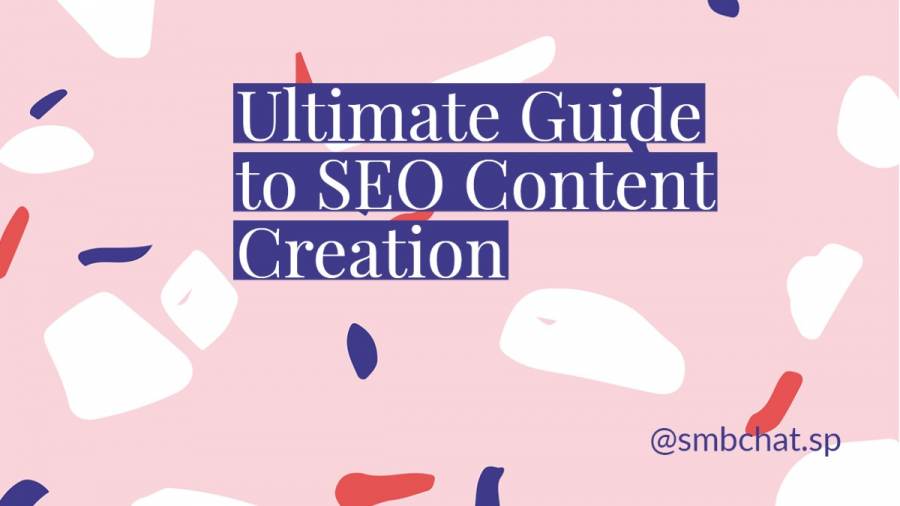Blog SEO 101: How to Optimize Your Blog Content for Higher Rankings
Dream with me for a moment.
Imagine a near-distant future where we're all gathering freely once more.
You and I are attending the year's biggest content marketing conference.
Before we head to the event center for meet-and-greets, talks, and presentations, we agree to meet at the quaint little coffee shop around the corner near our hotels.
We sit at a table by a window, looking out onto the sunny city street. Bright-eyed, early shoppers pass by laden with bags, and business people in suits and blazers hurry by on their way to their first morning meetings.
We sip our coffees and chat idly about the upcoming events of the day. We even indulge in a little gossip.
After my last sip of cappuccino, I ask, "So how are your blog posts doing?"
You reply with a lifeless mutter and a pained sigh:
"They could be doing so much better."
I lean in and give you my full intention while you lay out a laundry list of problems:
- None of your blog posts has ever topped search rankings. Ever.
- You know all about keyword research tools, as well as their benefits, but you've never procured any.
- You're super-focused on quantity and obsessed with pushing content just to get it out there. Ergo, much of your blog content is just okay, while most of it is downright rushed and bad.
- Low search volume. High bounce rate. Low click-through rate. Those three terms pretty much sum up your blogging journey thus far.
- Your main competitor, on the other hand, has a couple of high-ranking blog posts and is jumping ahead of you in leaps and bounds with the organic traffic they're pulling in.
And the list goes on.
You sit back on your chair, rubbing your temples. Just thinking about the situation gives you a headache.
You know what I'm going to say, but I say it anyway.
"You need to SEO your blog content."
Blog SEO: The Numbers Behind the Hype
Even though this is an imaginary situation, the point still stands. If you are like most business owners, some or all of this rings true.
Still in doubt?
Check out these statistics:
- On average, companies who blog produce 67% more leads per month
- Companies who blog get 97% more links to their websites
- 72% of online marketers describe content creation as their most effective SEO tactic
- Quality content is ranked as the #1 most important factor among all bloggers
- 23.84% of readers say poor content quality destroys a blog's credibility
- Updating blog posts can increase traffic by 106%
- The #1 traffic source for high-income bloggers is organic traffic from Google.
As you can see, optimizing blog posts for SEO is important. It's a no-brainer. It's a must.
You need to do it ASAP, and I'm here to tell you how (Imagine me giving you this advice over that same cup of coffee from our hypothetical friendly chat, wink.)
Your Blog Post SEO Checklist: 12 Tried-and-True Ways to Optimize Your Blog Posts for Higher Rankings
Here's the thing:
Today, you can't earn high search rankings with just any old content. Organic Google rankings are incredibly hard to earn, with zero-click searches rising to nearly 65% in 2020.
The crux of earning that top spot on Google?
High-quality content, laser-focused to your audience.
Here's the cheatsheet to writing blogs that engage, captivate, and above all convert.
Great blog SEO writing requires you to focus on a curated list of keywords while making sure your content is still beautifully crafted and reads like a human wrote it. It means knowing what your audience is looking for and optimizing it well.
Unless you know how to optimize blog content around the anomaly that is Google's search engine, you're fighting a losing battle with SERP-focused blogging.
But, good news—we've compiled plenty of information to guide you on your blog SEO journey right here, right now. Ready?
Step #1: Get Inspiration from What Works: SEO-Optimized Blog Samples that Work
With so many great individual posts on Google, you have plenty of competition. But you also have plenty of inspiration.
Before we cover step one, we'll preface it with step zero. Remember this point before lifting a finger on any future blog posts, SEO-focused or not.
Be original.
Copying work will tank your brand and alienate your target audience. However, there's nothing wrong with getting inspired by the work of others.
If you look at the high-ranking types of content in any given web search, you'll notice that a lot of it looks similar. It isn't copied, and there is variety, but there's a certain approach that has proven to work, time and again.
Let it inspire your own content creation process.
Worried your blog post ideas will be a little too inspired? Thankfully, there are handy tools you can use to tell if your posts are original enough, including EduBirdie, Copyleaks, and Copyscape.
Source: Copyleaks
Step #2: Understand Your Audience
Over and over and over again, a question you should be asking yourself before writing posts for SEO is who are you writing for?
You're not writing content for yourself. You are not writing for your brand.
You're writing for the people who need solutions your brand offers.
"Who are you writing for?" is crucial to know, but once you have it figured out, don't rest on your laurels. Your blog target audience isn't a static entity, but rather a living, breathing, ever-changing organism.
They're people, and people's desires and needs grow and evolve right along with them.
That said, have a good grasp of the answers to these three questions, and you'll be good to go:
- What questions do my target audience have about my products/service?
- What types of content do they like to read?
- Can I speak to their pain points and fears through blogging?
This laser focus on your audience is absolutely crucial. It's what differentiates quality content that gets read from the jibber-jabber that gets lost in the online trash heap.
Step #3: Target 1-2 Long-Tail Keywords
So, you know your audience inside-out. (If you don't, please go back to Step #2 and get clear on this. You can't move forward without this knowledge).
Now it's time to leverage your audience's insight and use it to ideate your content topics and keywords.
First, put together a list of long-tail keywords for your content.
For example, if you're a dentist doing search engine optimization to increase your clinic's ROI, here are three topics you could write about in your blog:
- Healthy teeth
- Sedation dentistry
- Teeth whitening
The next step is to come up with a list of long-tail keywords for each piece of content your produce. You can use tools like SEMrush, Google Search Console, and KWFinder to find high-opportunity long-tail keywords.
These high-opportunity keywords all follow a specific formula. Usually, they:
- Are highly specific
- Have relatively high search volume (people are actually typing them into search engines)
- Have low search competition (don't confuse this score with keyword difficulty—competition shows how many advertisers are bidding to show up in paid spots in results for the target keyword)
- Have low keyword difficulty (a metric that rates how hard it is to rank for a keyword)
- Most SEO tools have their own method for determining difficulty scores. For instance, Here's how SEMrush does it:
Click here to see the remaining steps.
If this is a lot to take in, I get it. These criteria seem like a lot to juggle at first.
But with witty, consistent research, the sweet spot, where a long-tail keyword is balanced between high search volume, low competition, and low keyword difficulty, won't seem so daunting anymore.
Back to our dentist example...
Ideal long-tail keywords for the above topics would be:
- Organic solutions for strong, healthy teeth
- Sedation dentistry for people with high blood pressure
- Safe teeth whitening procedures for adults
Wondering why I emphasized on two long-tail keywords per post?
Because Google hates keyword stuffing (i.e., sprinkling in 110 keywords in a 1000-word article for the sole purpose of ranking highly on SERP)
Besides, keyword stuffing doesn't make for a good user experience—a ranking factor that search engines now prioritize to ensure you're answering the search intent of your visitors.
Therefore, use keywords in a way that doesn't feel forced or unnatural.
(Remember our hypothetical chat? Why don't we skip the next event and get our coffee cups refilled? These next steps are major; you wouldn't miss them for the world!)
Step #4: Place Keywords Strategically throughout the Entire Post
Now that you've got a focus keyword or two, it's time to incorporate them into your blog post.
Generally, there are five spots you should try to infuse keywords:
- URL: Recent research has revealed that URLs that include a keyword have a 45% higher click-through rate. URL is the first thing search engines will crawl on your post, so including a relevant keyword in it not only increases your post's CTR rate, but also gives you an opportunity to rank higher.
- Title Tag/Headline: The quickest way for readers and Google to determine relevant content? Glancing at the title tag! So it's important that you include a keyword here. Even better, include your focus keyword within the first 60 characters of your title.
- Meta Description: Did you know that pages with a meta description get 5.8% more clicks than those without one? That's to say meta descriptions are a strong search engine ranking factor. The best way to create descriptive, edge-of-the-seat meta descriptions is to infuse a long-tail keyword right in the heart of it.
- Headers & Body: It can be tricky, but try using your keywords in the most logical and natural way. Instead of staffing your focus keyword into every sentence, use synonyms as well as LSI keywords.
- Introductory Sentence & Final Paragraph: Keeping the average keyword density in mind (ideally 1-2%), creatively tie in your target keyword or its synonyms in the blog's first sentence and the conclusion.
Step #5: Optimize Your Images
Image optimization isn't a foreign concept, is it? However, you'd be surprised by the number of business owners who fumble at this crucial step.
Beyond text optimization, your blog's SEO strategy needs to be built on the foundation of carefully chosen, well-optimized images.
Assuming you already have pictures placed within your post, optimizing them goes like this:
- Add alternate text to every picture: This is super important for SEO rankings! Alternate text is a descriptive text that provides context for visually impaired individuals or those who need to use screen readers to browse the web. Alternate text, or "alt text," describes your images to search engines as well, so they'll potentially show up in image searches.
- Make sure they're inserted correctly. Don't place images in a way that messes with paragraph formatting (i.e., keep them centered, in-between paragraphs).
- Images for SEO should be original size to ensure they're crisp and clear. Only size down if they're large or the file size is inflated (anything over 4-5MB can be scaled back without sacrificing pixel quality).
- Use unique images. Using stock pictures is fine, but they won't necessarily help your search engine ranking. In the same way that unique content is better for SEO, it's a good idea to upload unique images whenever possible.
Step #6: Check Your Links (Outbound Links, Internal Links…Everything)
Next up: Check those links!
(**Proceeds to order yet another cup of that delectable cappuccino**)
- Broken links are a BIG no-no
- Make sure all links pointing off-site (aka outbound links) are set to open in a new window. That way, you won't be directing readers to a non-existent page.
- For every link in your post—whether it links internally to your other blogs or webpages or points to another site—make sure it works.
Step #7: Reference Other Articles Or Bloggers with Links Inside the Post
In movies, they call it paying tribute. In the novel-writing world, they refer to it as acknowledgment. In the blog SEO scene? We call it referencing.
Whenever you mention another article or blogger in your post, include a link to the information you're referencing.
Other than the fact that it's good blogging etiquette, you may also get lucky and receive a link back. Needless to say, quality backlinks are a valuable commodity for any site looking to scoop up that coveted #1 on SERP.
Step #8: Whip In an Irresistible Headline
What's the difference between an article that gets read and one that irks readers?
The blog title.
Those that told us not to judge a book by its cover lied to us. Let's face it. As far as blog posts go, judging books by their covers is an inevitability (and can you blame us?)
To that effect, aim to write catchy titles, the ones that lure in your ideal reader in a split second.
Compelling titles:
- Pique the reader's interest right from the off
- Creatively weave in the focus keyword
- Are specific, concise, and deviate from giving too much away
- Have the right word count and balance (effectively utilize power, emotion, common, and uncommon words)
Step #9: Format the Blog Post for Readability
Another must-do for blog SEO is formatting your post for readability.
If your post isn't formatted, organic traffic may leave as soon as it arrives. Text blocks can repel even those who were drawn by your catchy blog post title. Most people, your ideal reader included, stay on a website for no more than 15 seconds.
Source: NN/g
When crafting your format, the following are staples for almost any type of content:
- A Well-Structured Title: Yes, you might have a catchy blog title, but if it's not properly structured, readers will still bounce. Not sure if your title is good enough? Consider using tools like IsItWP or Sharethrough Headline Analyzer.
- Short, Punchy Paragraphs: While the issue of paragraph length is subject to debate depending on the type of content in question, most people deem shorter paragraphs as the best. They're much easier to read. They also make your lines punchier, more impactful.
- Fix Your Spacing: Ensure spacing around images is consistent, remove double spacing after periods, and add more paragraph breaks where your text looks dense.
- Above All, Be Consistent: If you format your sub-headers with bullet points, keep doing it throughout the post. If you use auto-formatted bullet points, use them every time you need a bulleted list. Consistent formatting keeps things looking neat and clean, not to mention easier to read.
Step #10: Widen Your Blog Posts' Reach through Social Sites
Guess what?
Facebook has more daily users—1.908 billion—than India has people. And on average, 20000 users are active on this platform per second (yup, just 1 second!)
What am I driving at?
Social media sites are a goldmine if you want to broaden the reach of your blog posts. Other than Facebook, there's Twitter, Google+, and LinkedIn—all robust social platforms capable of catapulting your content to stardom.
But you have to start somewhere, right? Thankfully, free tools like Hootsuite are conveniently at your disposal. With just a few clicks, you can post links to your latest posts on all of your social platforms. You can even schedule your posts ahead of time!
Step #11: Revise, Edit, and Refine Your Work before Hitting “Publish”
Today, your job as a business owner and content creator isn't simply to push out written material—it's to create targeted, from-the-heart, complete content that provides something different, that hits your audience right in the feels, and that comes from a place of true passion and belief.
To get to this place, you've got to be tough. Ruthless. Uncompromising.
Develop an eye for excess, and understand that creating valuable content often means walking away from much of it.
In other words, learn to edit like a professional.
Source: PR Daily
You don't just edit your posts to find awkward phrases and typos, though those are both important to catch. You edit to see if there's anything you can add.
There's also the issue of grammar. Luckily, tools like Grammarly can help you weed out things like the dreaded passive voice and to-too-and-two.
Have you sprinkled in the right amount of keyword phrases? Could you use a few more images? Are all your points clear, concise, and factual? Does your table of contents encompass everything you've listed out in the blog?
Revising and editing give you the chance to touch up your post and make sure it is everything it needs to be to rank top on SERP.
"The first draft reveals the art; revision reveals the artist."
Step #12: Track Your Results, Let them Fuel Your Content Strategy Going Forward
After you've edited your post and sent it out to the webspace, you're done. Right?
Erm, not quite.
Of course, you'll keep churning out high-quality content, and marching towards the pinnacle of SERP like the SEO champion that you are. But you'll also be doing some tracking.
You can track your site in general, as well as individual posts to see how well they're doing. Tools like Tableau, Momently, and BuzzSumo can help with this.
When you monitor your posts' performance metrics, you get a better understanding of whether your current content strategy is up to par. The benefit to this is you'll always have the wriggle room to improve it.
Writing posts for SEO isn't about finding a perfect solution—it's about tweaking your writing habits, in perpetuity.
Raking Success Is Well Within Reach. Grab It!
With the billions of Google searches happening every day, it's easy to think that your blog posts will never be found out, let alone rank highly.
But from what we know about Google's ranking algorithm, there's every chance for your posts to hit the top of that SERP mountain. All it takes is smart, consistent, and sometimes grueling SEO-focused blogging work.
The intensive keyword research. The ruthless editing. The work ethic for tracking your metrics on the fly. It'll all be worth it in the end.
Remember…
Legitimately good content will always rank highly. Good content is informative. It's pleasant to the eye. It's filled with pizzazz. The page looks like a work of art, and the blog post itself reads like an expert manuscript.
Don't have time to DIY?
Let Zoey Writers do the heavy lifting for you.
Our team is well-versed in writing sweater-knit, intuitive, crisp SEO content. Outsource your SEO posts to us!

















